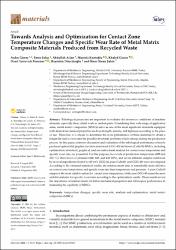Towards Analysis and Optimization for Contact Zone Temperature Changes and Specific Wear Rate of Metal Matrix Composite Materials Produced from Recycled Waste

Göster/
Erişim
info:eu-repo/semantics/openAccessTarih
2021Yazar
Gunes, AydinSalur, Emin
Aslan, Abdullah
Kuntoglu, Mustafa
Giasin, Khaled
Pimenov, Danil Yurievich
Duzcukoglu, Hayrettin
Sahin, Omer Sinan
Üst veri
Tüm öğe kaydını gösterÖzet
Tribological properties are important to evaluate the in-service conditions of machine elements, especially those which work as tandem parts. Considering their wide range of application areas, metal matrix composites (MMCs) serve as one of the most significant materials equipped with desired mechanical properties such as strength, density, and lightness according to the place of use. Therefore, it is crucial to determine the wear performance of these materials to obtain a longer life and to overcome the possible structural problems which emerge during the production process. In this paper, extensive discussion and evaluation of the tribological performance of newly produced spheroidal graphite cast iron-reinforced (GGG-40) tin bronze (CuSn10) MMCs, including optimization, statistical, graphical, and microstructural analysis for contact zone temperature and specific wear rate, are presented. For this purpose, two levels of production temperature (400 and 450 degrees C), three levels of pressure (480, 640, and 820 MPa), and seven different samples reinforced by several ingredients (from 0 to 40 wt% GGG-40, pure CuSn10, and GGG-40) were investigated. According to the obtained statistical results, the reinforcement ratio is remarkably more effective on contact zone temperature and specific wear rate than temperature and pressure. A pure CuSn10 sample is the most suitable option for contact zone temperature, while pure GGG-40 seems the most suitable material for specific wear rates according to the optimization results. These results reveal the importance of reinforcement for better mechanical properties and tribological performance in measuring the capability of MMCs.

















